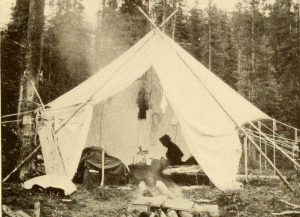—This post was written by Elsa Miller, Spring 2016 intern at the American Art & Portrait Gallery Library (AA/PG). The American Art and Portrait Gallery Library (AA/PG) has an extensive more »
Smithsonian Libraries and Archives / Unbound

What are your plans for National Camping Month? Thinking of bringing along a sketchbook? You’d be in good company.
Mary Vaux Walcott (1860-1940) was undoubtedly a pro at camping. The naturalist and botanical illustrator spent the summers of her youth in the Canadian Rockies with her well-to-do family, where she became an active mountain climber, outdoorswooman, photographer, and started her first forays into botanical illustration. It was later in life, in her mid fifties, when she married the then current Secretary of the Smithsonian, Charles Doolittle Walcott, against the objections of her father.
This is a guest post by Charles Solomon, 7th grader at Forsythe Middle School (Ann Arbor, Mich.), who accompanied his father, Matthew Solomon, to DC for his March 3 lecture, Fantastic Voyages of the Cinematic Imagination at the National Museum of American History. The lecture was presented in tandem with our current exhibition, Fantastic Worlds: Science and Fiction, 1780-1910.
The Biodiversity Heritage Library (BHL) and Smithsonian Libraries staff participated in BioBlitz 2016 in Washington, D.C. on 20-21 May. A BioBlitz focuses on finding and identifying as many species as possible in a specific area over a short period of time. In this special edition of the BioBlitz, held in conjunction with the National Park Service’s centenary, the D.C. BioBlitz was accompanied by a two-day Biodiversity Festival on the National Mall at Constitution Gardens. The event was co-hosted by the National Park Service and National Geographic.
 The Smithsonian American Art and Portrait Gallery (AA/PG) Library is pleased to present an exhibition of some of its recently acquired artists’ books in the Library’s Reading Room.
The Smithsonian American Art and Portrait Gallery (AA/PG) Library is pleased to present an exhibition of some of its recently acquired artists’ books in the Library’s Reading Room.
The books, all acquired in the last two years, range from mass-produced publications to unique, hand-made book works. The artworks show a range of subjects, from the very personal, family stories, to the cult of celebrity.
Fold-out plates are often used to feature important illustrations or diagrams in many books related to science, technology, and history. Though a fold-out is designed to be frequently folded and unfolded, the stress on the creased fold lines from constant handling often causes the paper to break.
It’s easy to take a book for granted and not think about the machines and time it took to make the book, especially in the nineteenth century. The Trade Literature Collection includes catalogs for bookbinding and printing machinery. Some of those machines are shown in this 1892 Montague & Fuller trade catalog.
